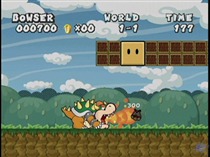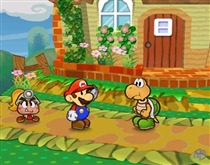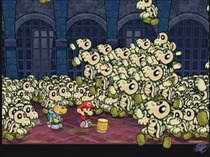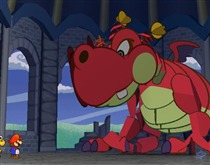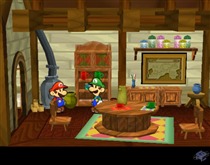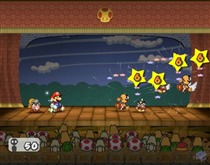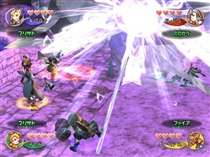We take a look back at the games worthy enough to be considered the GameCube's best.


Paper Mario: The Thousand-Year Door
Released October 11, 2004
Developed by Intelligent Systems
Published by Nintendo
Retrospective by Evan Burchfield
Square's Super Mario RPG and Intelligent Systems' Paper Mario games all prove that there is room for simplified, all-ages RPGs in the video game market. The Paper Mario series in particular streamlines the methods of typical RPGs, eliminating some of their faults and introducing new elements. For all their audacious and risky design, the games are seemingly accomplished with ease, and it is with ease that you can play through Paper Mario: The Thousand-Year Door for GameCube.
Nintendo has never attempted or licensed a typical RPG (Fire Emblem doesn't count), and they never will –the genre contrasts with their principles so much that Super Mario RPG seemed a bizarre concept when it was first announced. Considering that the Japanese RPG as we know it today was born and later flourished almost exclusively on Nintendo systems, it is extremely unfortunate that today most RPGs are made for other systems. The Paper Mario games don't fill the void, but they offer such a fresh perspective on RPG structure that playing them is really a joy.
The Paper Mario games exist as criticism of the RPG genre: By sharply modifying a typical RPG to encourage active participation at all times, the games point out some of the hindrances to modern RPG structure. There is always something to do during a battle by way of action commands that allow you to block, increase your attack power, or aim your attacks. There are plenty of methods of attacking and lots of strategies, but they are not myriad – the game's simplicity is its strength. Combined with the badge and buddy system, battles stay fun without becoming overwrought.
What sets Thousand-Year Door apart from its predecessors is that it is far, far funnier, which is saying a lot. Both Super Mario RPG and Paper Mario 64 had plenty of humor, but thanks to NOA's new localization team, Thousand-Year Door has some of the funniest dialog ever in a Nintendo game. My favorite part was Luigi's "sidequest" that mirrored Mario's and was obviously not going as well – the game took this opportunity to poke fun at its own absurdities.
Since GameCube was not exactly (read: not at all) a system for RPG fans, it is appropriate that its best entry in the genre is untraditional. Paper Mario: The Thousand-Year Door is a Mario game, a quasi-sequel to Super Mario RPG, and another jewel in Nintendo's "Gameplay is King" crown.
Thoughts From the NWR Staff
Michael Cole: "The paper world introduced on the N64 was fully realized in its GameCube sequel, The Thousand Year Door. While at times it felt similar to its N64 predecessor, its memorable characters, clever Nintendo references, and interesting side quests set it apart from most other child-friendly RPGs. How can you not love the game that finally brought 'Shine Get!' to American shores?"
Jon Lindemann: "Like the Mario & Luigi games, Super Mario RPG, and Paper Mario before it, Thousand Year Door combines easily accessible gameplay with razor-sharp wit and plenty of recognizable characters. It may look like a kiddie game on the surface, but like a Bugs Bunny cartoon or a Pixar movie, only adults can truly appreciate its humor. A must-play for Nintendo fans, it's a game that you can't help walking away from with a smile on your face."
Steven Rodriguez: "Paper Mario on the N64 was such a joyride. The storytelling and the oddball situations Mario and Co. found themselves in were so much fun to run through. Thousand-Year Door took all of that and amplified it to the next level. It's a perfect mix of old-school and new-school that anyone can enjoy."
Jonathan Metts: "This was the first RPG that I played through in Japanese. Luckily that wasn't a crippling barrier, but I did have a ton of trouble on the train level where you have to talk to a dozen characters in sequence. It's a colorful, funny game that anyone can pick up and enjoy...despite Game Informer's claims about the game's mainstream appeal."
David Trammell: "Alas, I have not yet played through this game. I do own it, but my time is at a premium, and I haven't yet found that perfect mix of factors that will allow me to properly enjoy this game. I have played the original though, so I know that in time I'll make time for Paper Mario."
A Dissenting Opinion
Karl Casteneda: "Everyone always raved about this game as one of the elite GameCube RPGs, so I checked it out. Once I got over the gorgeous visuals and quirky dialogue, however, I realized that it's pretty boring. It seems more like a 'My First RPG' than anything else - I greatly prefer the vastly superior Superstar Saga."
Paper Mario is, of course, the spiritual successor to the Square-developed Super Mario RPG on the SNES. Square famously left Nintendo after the N64 was revealed due to a conflict of vision for the future of games. Square landed on the PlayStation where they created some of the most popular RPGs ever, and no matter how derided they are by Nintendo fanboys, these games set the standard for what an RPG should be in the 3D world. For those who only play on one console, this was a huge blow.
Square's eventual "return" to Nintendo during the GameCube era (the company since rechristened Square-Enix) was hardly a return at all, but it was heralded as the reunion the gaming world had been waiting for. Square-Enix began re-releasing their old Super Nintendo classics on Game Boy Advance while developing a Final Fantasy side quest (Crystal Chronicles) for GameCube. Although multiplayer focused, the game received solid reviews and was moderately successful. The main Final Fantasy games have stayed on PlayStation ever since the infamous breakup, making Square's return exciting, but half-hearted.
